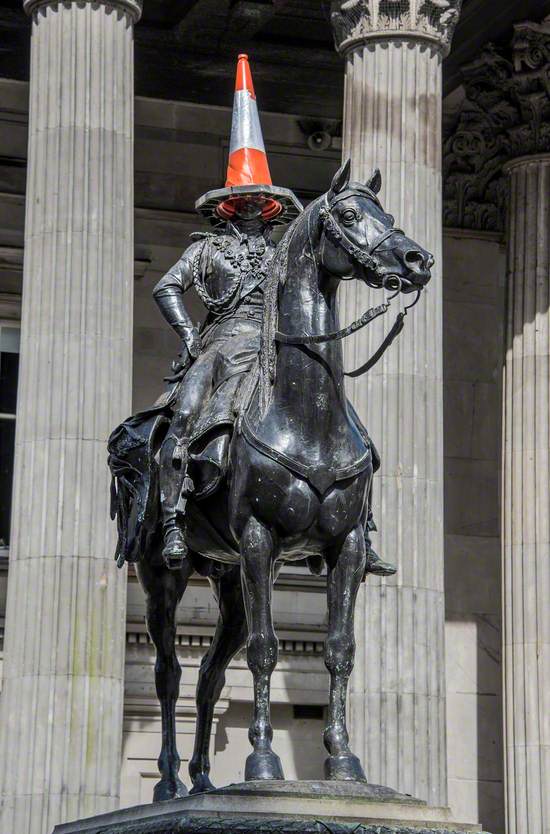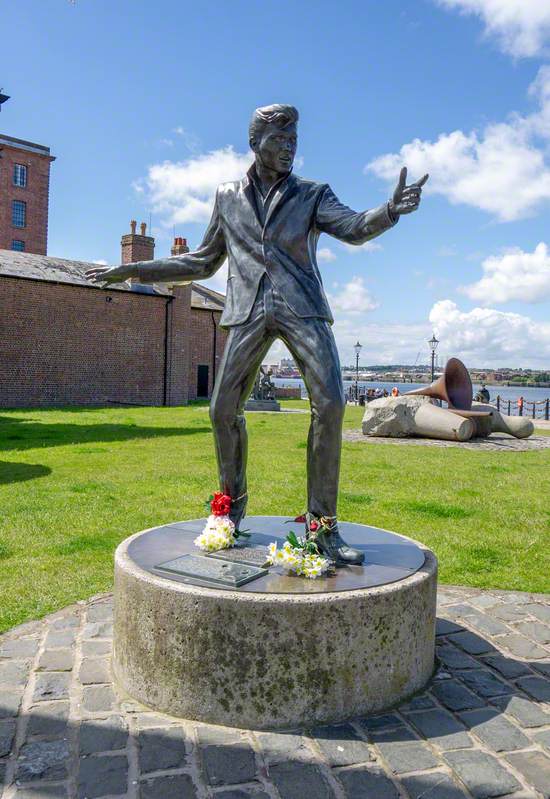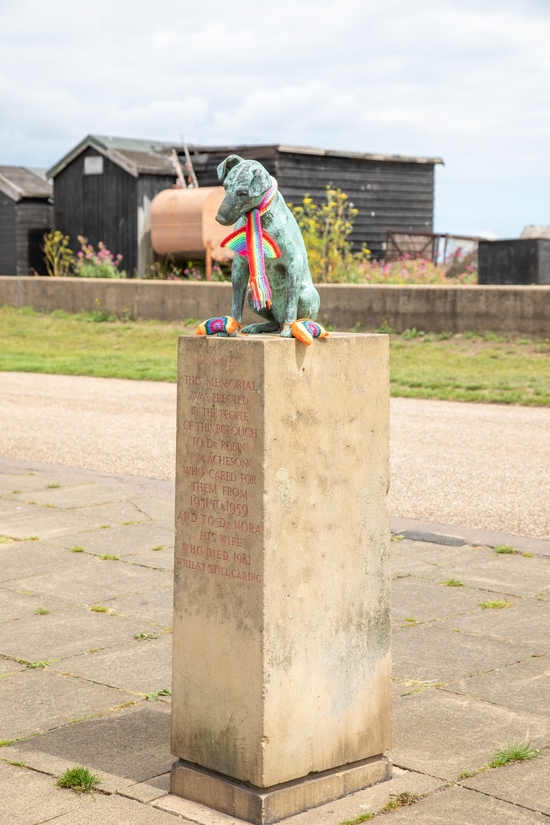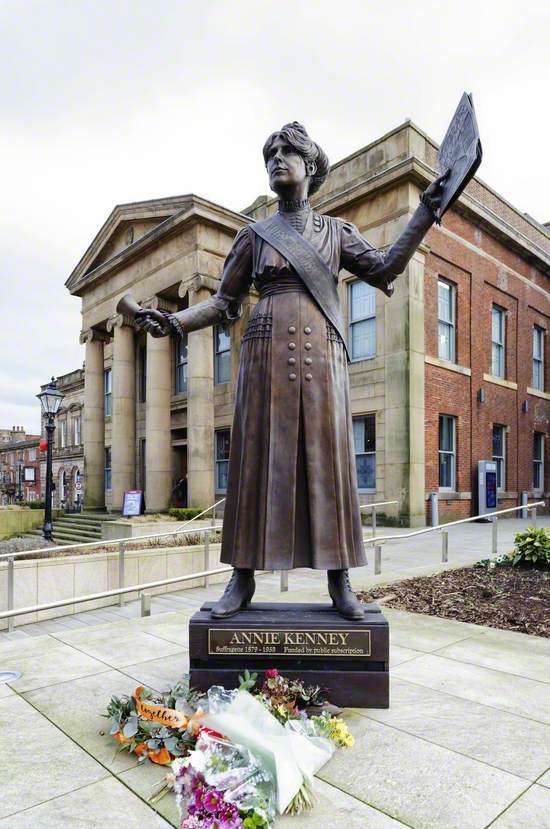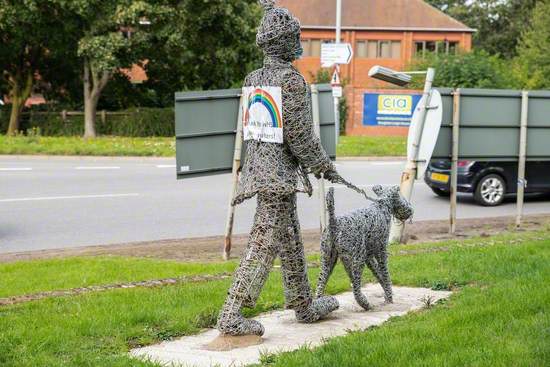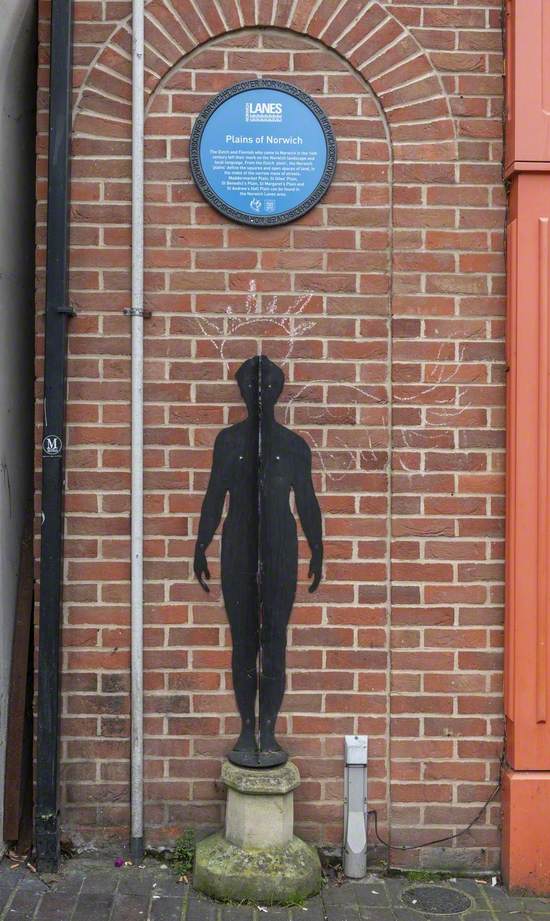There is something about public statues and sculptures that inspires people to add clothes and other accessories to them. Some decoration is whimsical and funny, whilst others are making a statement or are an act of remembrance.
Our volunteer team captured images of thousands of public sculptures as part of the Art UK Sculpture project. Many had been decorated when they arrived with their cameras, but rather than remove the decoration, they photographed them as they looked on that day.
Here are a few example of public sculptures with additional decoration which can be seen on Art UK.
Sir Henry Doulton
I pass this statue in Stoke-on-Trent fairly regularly and he always has something around his neck. It's often just a tie, but for the last couple of years there's been a mug attached to one of the ties, presumably to celebrate Doulton's role in ceramic production in the City. Occasionally a Port Vale Football Club scarf will be added, as their home ground is just up the road. Doulton is quite high up from the pavement, so it must be a feat of endurance to climb up and decorate him.
Duke of Wellington
Probably the best-known decoration of a public statue in the UK is the traffic cone on Wellington's head in Glasgow. This is a semi-permanent feature; as soon as it is removed a new cone will appear.
Carlo Marochetti (1805–1867) and Soyer and De Braux and James Smith (1808–1863)
Bronze & Peterhead granite
H 360 cm
Queen Victoria
This statue in Liverpool was photographed when it had been decorated for the Sky Arts tv programme 'Statues Redressed'. Fashion Creative Karen Arthur collaborated with historian Laurence Westgaph, to create a cotton and hessian dress for Queen Victoria inspired by 'Gone With The Wind'. During Victoria’s reign, cotton played a crucial role in Liverpool’s trading activities, and the wider economic success of Britain, but up until the American Civil War in the 1860s, this cotton was being picked by enslaved people in the United States - as depicted in the film. This piece reflects on Liverpool’s complicity with slavery, and how Queen Victoria and Britain were beneficiaries of that as recently as 150 years ago.
Charles John Allen (1862–1956) and Frederick Moore Simpson (1855–1928) and A. B. Burton (active 1874–1939) and W. Thornton and Sons
Portland stone, bronze, lead & gold mosaic
H 1830 x W 2740 x D 2740 cm
Billy Fury
This statue in Liverpool celebrates the rock and roll star Billy Fury, who was born in the City. Fans of the late singer have placed flowers at his feet.
Monument to the Unknown Woman Worker
Two figures of 'working-class' women with symbols of womens' work embedded in the surfaces; domestic items such as colanders, a shopping basket and clothes pegs form parts of the sculpture. The work shows the ephemera of low paid jobs and housework, including a typwriter, telephone, and clothes hanger. Someone has yarn-bombed the statue by adding crochet decorated with small flowers to one of the women's ankles.
Snooks
Tracy Jenkins, Art UK's Public Sculpture Officer, described photographing this artwork as part of the sculpture project: 'When I arrived to photograph the statue of a dog called Snooks at Aldeburgh, he had been yarn-bombed. Sculptures, once unveiled, become a member of the community in which they live. From time-to-time, clothes or accessories are added. When I took this picture, many eyes were watching me as I loosened the scarf to record the markings on the collar of the sculpture. As an outsider it was not my place to intervene.'
Resolution
An upright cast iron figure constructed from small cubes of metal. This was Gormley's first artwork located in the City of London. A garland of flowers has been placed around the figure's neck.
An Gof
These statues commemorate the Cornish uprising of 1497, a protest against taxes levied by the English government to finance a war against the Scots. A peaceful march to London to take their grievances to the King ended in bloodshed at the Battle of Deptford Bridge. Tinsel has been placed around the shoulders of the two men depicted in the statues, Michael Joseph An Gof and Thomas Flamank, who sadly lost their lives as a result of the rebellion.
Annie Kenney
This statue in Oldham, Lancashire, commemorates suffragette and social feminist Annie Kenney, a leading figure in the Women's Social and Political Union. The statue depicts Kenney wearing a votes for women sash and ringing a bell, while standing on an orange box. Flowers have been placed in front of the statue.
Man Walking a Dog
This artwork in Rugby, Warwickshire, was decorated during the global pandemic with a sign which says 'Thank You NHS and Keyworkers'.
Sappho
This kneeling statue of the poet, Sappho, is sited in Letchworth to depict the historic link between the garden city and women’s suffrage. The statue's head has been decorated with red poppies on a green headband.
The Hugglescote Bear
Another example of a sculpture which has been decorated with commemorative red poppies. The sculpture was erected to celebrate the legend of how Hugglescote in Leicestershire was named. The legend tells the story of a villager named Huggle who was chased by a bear. His heavy coat was slowing him down, so he threw it aside. The bear stopped to investigate the coat instead of pursuing Huggle, and he was therefore able to escape. The legend became popular in the area, and the village was called then called Hugglescote.
Joe Darby Obelisk
Joe Darby specialised in spring jumping (jumping starting from a stationary position) often using weights in his hands to help propel him. After taking part in competitive jumping at venues in the Midlands and North of England in the 1880s, he went on to perform at theatres in London and Paris and crossed the Atlantic to exhibit in North America. He entertained crowds by performing trick jumps and earned money in wagers with competitors. Highlights in his career included defeating the American World Champion spring-jumper in 1887 and appearing before the future King Edward VII in London. A flag, possibly the one for Portugal, had been secured around Joe's neck when Art UK photographed this statue.
Wall Sculpture
A different type of decoration has been added to this sculpture in Norwich, with a crown and a wing having be chalked onto the wall behind the artwork. This decoration has probably washed away now.
Explore artists in this Curation
View all 20-
 De Braux
De Braux -
 Tom Murphy (b.1949)
Tom Murphy (b.1949) -
 Thomas Kenrick (b.1982)
Thomas Kenrick (b.1982) -
 Charles John Allen (1862–1956)
Charles John Allen (1862–1956) -
 Soyer
Soyer -
 Steve Field (b.1954)
Steve Field (b.1954) -
 Colin Melbourne (1928–2009)
Colin Melbourne (1928–2009) -
 Denise Dutton
Denise Dutton -
 W. Thornton and Sons
W. Thornton and Sons -
 Carlo Marochetti (1805–1867)
Carlo Marochetti (1805–1867) - View all 20

